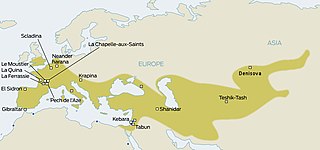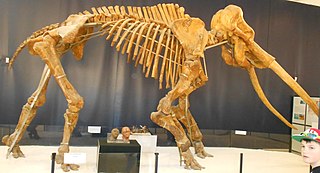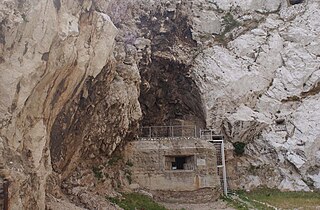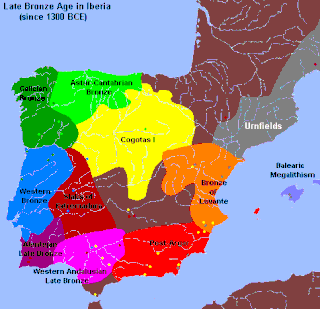
The Mousterian is an archaeological industry of stone tools, associated primarily with the Neanderthals in Europe, and to the earliest anatomically modern humans in North Africa and West Asia. The Mousterian largely defines the latter part of the Middle Paleolithic, the middle of the West Eurasian Old Stone Age. It lasted roughly from 160,000 to 40,000 BP. If its predecessor, known as Levallois or Levallois-Mousterian, is included, the range is extended to as early as c. 300,000–200,000 BP. The main following period is the Aurignacian of Homo sapiens.
The Atapuerca Mountains is a karstic hill formation near the village of Atapuerca in the province of Burgos, northern Spain.

The European wild ass or hydruntine is an extinct equine from the Middle Pleistocene to Late Holocene of Europe and West Asia, and possibly North Africa. It is a member of the subgenus Asinus, and closely related to the living Asiatic wild ass. The specific epithet, hydruntinus, means from Otranto.

The straight-tusked elephant is an extinct species of elephant that inhabited Europe and Western Asia during the Middle and Late Pleistocene. It was larger than any living elephant, with adult males suggested to reach 3.81–4.2 metres (12.5–13.8 ft) in shoulder height, and 11.3–15 tonnes in weight. Like modern elephants, the straight-tusked elephant lived in herds, flourishing during interglacial periods, when its range would extend as far north as Great Britain. Skeletons found in association with stone tools and wooden spears suggest they were scavenged and hunted by early humans, including Neanderthals. It is the ancestral species of most dwarf elephants that inhabited islands in the Mediterranean.

Gorham's Cave is a sea-level cave in the British overseas territory of Gibraltar. Though not a sea cave, it is often mistaken for one. Considered to be one of the last known habitations of the Neanderthals in Europe, the cave gives its name to the Gorham's Cave complex, which is a combination of four distinct caves of such importance that they are combined into a UNESCO World Heritage Site, the only one in Gibraltar. The three other caves are Vanguard Cave, Hyaena Cave, and Bennett's Cave.

The cave hyena, also known as the Ice Age spotted hyena, is a paleosubspecies of spotted hyena in Eurasia, which ranged from the Iberian Peninsula to eastern Siberia. It is one of the best known mammals of the Ice Age and is well represented in many European bone caves. It preyed on large mammals, and was responsible for the accumulation of hundreds of large Pleistocene mammal bones in areas including horizontal caves, sinkholes, mud pits, and muddy areas along rivers.

The Taifa of Algeciras was a medieval Muslim taifa kingdom in what is now southern Spain and Gibraltar, that existed from 1035 to 1058.

Neanderthals are an extinct group of archaic humans who lived in Eurasia until about 40,000 years ago. The type specimen, Neanderthal 1, was found in 1856 in the Neander Valley in present-day Germany.

Prof. Clive Finlayson MBE FLS is a Gibraltarian zoologist, paleoanthropologist and paleontologist. He is the incumbent Director of the Gibraltar Museum. Finlayson has published various works mainly based on his research which includes ongoing excavations at Gorham's Cave in Gibraltar, the last known site of the Neanderthals.

The Gibraltar National Museum is a national museum of the history, culture and natural history of Gibraltar located within the city centre of the British overseas territory of Gibraltar. Founded in 1930 by the then Governor of Gibraltar, General Sir Alexander Godley, the museum houses an array of displays portraying The Rock's millennia-old history and the unique culture of its people. The museum also incorporates the remains of a 14th-century Moorish bathhouse. Its director since 1991 is Prof. Clive Finlayson.

Forbes' Quarry is located on the northern face of the Rock of Gibraltar within the Upper Rock Nature Reserve in the British Overseas Territory of Gibraltar. The area was quarried during the 19th century to supply stone for reinforcing the fortress' military installations. In the course of the quarrying, a limestone cave was found. The second ever Neanderthal discovery was made within this cave when Cpt. Edmund Flint found the skull of an adult female Neanderthal in 1848.

Vanguard Cave is a natural sea cave in the British Overseas Territory of Gibraltar which is part of the Gorham's Cave complex. This complex of four caves has been nominated as a UNESCO World Heritage Site status in 2016. The cave complex is one of the last known habitations of the Neanderthals, with a period of inhabitation from 55,000 to 28,000 years ago. It is located on the southeast face of the Rock of Gibraltar.

The Gibraltar Heritage Trust is a non-profit charity established by statute on 1 May 1989 to preserve and promote the cultural natural heritage of the British Overseas Territory of Gibraltar.

Ibex Cave is a limestone cave on the Rock of Gibraltar which has yielded stone artifacts of Mousterian tradition. It was discovered in 1975. It is so named as an ibex skull was found within the cave which would have been hunted by the Neanderthals of Gibraltar thousands of years ago. Ibex Cave was named and excavated by the Gibraltar Museum in 1994. Its first formal description was in 1999.
Bray's Cave is a limestone cave in the British Overseas Territory of Gibraltar. The cave has yielded several significant human remains and artifacts from the Neolithic and Bronze Ages. Three almost complete skulls were discovered, along with other cranial fragments from multiple individuals. This suggests that people repeatedly returned to the site to reuse it as a burial ground.
Boathoist Cave, also known as Bulman's Cave, is a huge sea cave on the south eastern flank of the British Overseas Territory of Gibraltar.

The Neanderthals in Gibraltar were among the first to be discovered by modern scientists and have been among the most well studied of their species according to a number of extinction studies which emphasize regional differences, usually claiming the Iberian Peninsula partially acted as a “refuge” for the shrinking Neanderthal populations and the Gibraltar population of Neanderthals as having been one of many dwindling populations of archaic human populations, existing just until around 42,000 years ago. Many other Neanderthal populations went extinct around the same time.

Roca dels Bous is an archaeological site located in Sant Llorenç de Montgai, in the Catalan Pyrenees, Spain. Since 1988 the Autonomous University of Barcelona and the UCL Institute of Archaeology study and record the fossil sequence of southern European Neanderthals who inhabited the area during the Middle Paleolithic approximately 50,000 years ago. The excavation team utilizes a worldwide unique digital system and various innovative technologies that significantly improve the quality of the classification of the recovered objects. Roca dels Bous has as one of the first Paleolithic excavation sites in Spain established a visitor centre, that focuses on displaying the Prehistory research of the prepyrenees area.
The University of Gibraltar is a degree-awarding higher education institution established by the Government of Gibraltar through the University of Gibraltar Act 2015. The founding of the university was described by Gibraltar's Chief Minister Fabian Picardo as "a coming-of-age" for the British Overseas Territory.

Named after its regional range, the Levantine Bronze Age refers to a culture extended over the actual territory of the Valencian Community, in the "Levante" or eastern side of the Iberian peninsula. Its chronological range was between 2200 BC and 1500 BC.
















